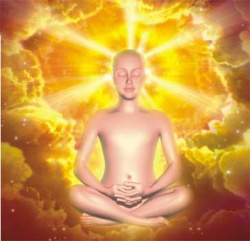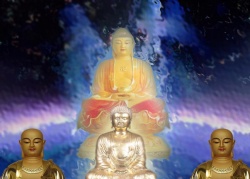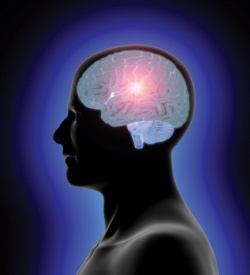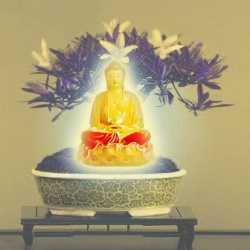The Life of Shakyamuni
Two days from today will be a holiday celebrating one of Shakyamuni's major deeds. For any activity the proper motivation, engagement, and dedication are needed.
This motivation differs between vehicles. In the Hinayana the motivation is to become enlightened. In the Mahayana it is compassion.
In the Vajrayana it is the five definitive features of the bodhisattva: the definitive time, place, teacher, and so forth. We should visualize the place of teaching as a Pure Land. We have not yet realized the ability to see this realm as a Pure Land, but we have the aspiration.
Without good motivation, wisdom can turn the wrong way. Some people have great knowledge and skill. But without proper motivation we can use our knowledge to harm people.
Next is proper engaging. We should practice without hope and attachment. Attachment is like glue. With attachment, we cannot be liberated. We should believe enlightenment can happen, but we should not seek it. It doesn't matter what you are attached to. Attachment is attachment.
The last is proper dedication. One moment's anger can destroy one hundred eons' virtue, but only if it is not dedicated to full enlightenment. Without dedication, virtue only arises as samsaric happiness. But if we dedicate merit, only holding the wrong view can destroy the merit.
Today's subject is Buddha's life story. If we discussed it in full, it would take eighty years. Buddha did not take one breath without benefiting sentient beings. Sherab Jugne taught Gampopa's life story for seven days.
If I tried to recall it, I couldn't teach for seven hours. And only one hour if I didn't have the texts. To recite all the sutras taught by the Buddha takes four months if you are a fast reader.
The first month of the Tibetan calendar is the Miracle month and all merit is multiplied 100,000 times. It celebrates the occasion when Buddha defeated six non-Buddhist teachers through the display of miracles The first day's miracle was when Buddha manifested a great tree from a toothpick.
On the second day he converted water offered to him into a lake. On the fifteenth day of the fourth month we celebrate the Buddha's enlightenment.
In reality he had already achieved Buddhahood, but he manifested it after six years of practice as a teaching for us.
The third occasion is on the fourth day of the sixth month. On this day we celebrate the Buddha's first teaching, the four noble truths. This was forty nine days after his enlightenment. He taught his first five disciples.
The fourth holiday is the descent of Buddha from heaven. Buddha's mother died shortly after he was born and he spent one summer teaching her the dharma in heaven.
The fourth day celebrates his return after giving this teaching. This day is the twenty second day of the ninth month.
The Tibetan calendar sometimes has repeated or skipped days. If a date is repeated, you celebrate the occasion on the first day. If it is skipped, you celebrate the day before.
To me a birthday means you are one year closer to death, But Buddhas and the great emanations don't care. They are born and die solely for the benefit of beings. If we don't want to hear them, they will not be reborn. Everyone is reincarnated, be we don't have the choice where and when.
Some people think the Buddha's life is not so important. But every moment of his life was a teaching. Traditionally his life is recounted as twelve great deeds.
In this text, the first verse is an homage to Shakyamuni. All texts start with an homage. The homage makes the text meaningful and is a short summary of the text. Before the Buddha was enlightened, he was born in a hell realm.
He was pulling a cart with someone else, who had trouble pulling the load. Buddha said spare the other person.
The demon driving the cart beat him to death and he was reborn in a god realm.
This was the first time he had engendered pure compassion. In another life the Buddha was a king. One of his elephants had been trained and he went on a ride with the trainer.
The elephant smelled a female and ran amok. The king asked, I thought you trained the elephant? The trainer said I can train the body, but not the mind. The king asked who can train the mind. The trainer said only the Buddha. So the king took refuge.
There are two kinds of bodhicitta: aspiration and action bodhicitta. Aspiration is like wanting to go somewhere. Action is actually going there. To become enlightened we accumulate merit and wisdom.
The first deed of the Buddha was twofold: descending from Tushita into this world and entering into the womb of his mother Mayadevi. The Buddha decided the proper time to be reborn. This is the worst of times, the degenerate age, with degenerate life span, delusions, persons, times, and view. It is a time when the afflictions are heavy. But Buddha decided to be reborn during this age.
All pratyekabuddhas are reborn within India. Twelve years before the Buddha was born the gods told the pratyekabuddhas a nirmanakaya buddha was about to be born.
The pratyekabuddhas rose into the sky and dissolved into the rainbow body. Their clothes fell on the people below. The Buddha manifested to his mother in the form of an elephant Sometimes your bardo form does not match your form in the past life.
There is also the case of a lama who manifested to his mother as a bull. So Buddha manifested as an elephant. Buddha was born in a family of the warrior caste because at that time they were held in the highest respect.
In Tibet, hunters, butcher, and smiths were considered low families. Smiths were held in low regard because they made weapons.
The second great deed is Buddha's birth with auspicious signs. He was born at Lumbini, which then was part of India, but now is in Nepal.
The king was friends with a sadhu. The sadhu flew from the Himalayas to examine the king's son. Upon seeing the son, the sadhu began weeping.
The king asked, is something wrong? He said no, he will become a great spiritual teacher, but I will die before he starts teaching.
The king wanted him to become a chakravartin (universal monarch), but the sadhu said, no,the signs on his body indicate he will be a Buddha, because a Buddha's marks are deeper and clearer than a chakravartin.
The third deed is Buddha displaying athletic skill. The fourth deed is ruling the kingdom with his princess. He married and had a son because otherwise people wouldn't respect him, thinking he was not fully a man.
The fifth deed is leaving home and becoming a wandering monk. His father tried to keep his son from leaving home with women, musicians, and guards. But Buddha wanted to discover the solution to birth, sickness, old age, and death.
When everyone fell asleep Buddha left home and cut his hair at Kasyapa's stupa.
He cut his hair to distinguish himself from other Hindus. His wife later reproached him saying who left his wife and son. Buddha replied, the person who left you is Sidhartha.
The person who stands before you is Buddha. We change our names when becoming Buddhist to indicate our change of attitude and thoughts.
The sixth deed is the practice of asceticism by the banks of the Nairanjana. When I visited India in the winter, this river was dry. Five attendants for the king and queen left home to practice with the Buddha.
He only ate fruit from the trees that grew nearby and got very thin.
He realized asceticism didn't work We need a middle path between asceticism and worldly life. He ate some rich food and his attendants left him, saying he had broken his ascetic vows.
The seventh deed was that he went to the vajra seat in Bodhgaya to meditate. This is the same place the previous three Buddhas of this eon became enlightened. The tour places where the Buddha was born, became enlightened, gave his first teaching, and died are recommended as places of pilgrimage.
The eight deed is turning the wheel of dharma. The first turning is teaching cause and result at Varanasi. The second turning is teaching emptiness at Rajghir. The third turning is teaching buddha nature.
The ninth deed is overcoming heretics and others in debate. The tenth deed is overcoming them by displaying miracles. He performed miracles to convince others and lead them to the dharma.
The eleventh deed is to die and enter parinirvana. According the the Hinayana, Buddha completely purified suffering by dying, by leaving his physical body.
In the Mahayana tradition his suffering was completely eliminated when the Buddha was enlightened. When Buddha sat beneath the bodhi tree, Mara challenged his right to become enlightened, because he hadn't accumulated three eons worth of merit.
The Buddha pointed to the earth and a goddess appeared to give witness for him.
The twelfth deed is the manifesting relics after the cremation of his body. There is an alternate way of numbering the deeds that splits the first deed into two and combines the two last deeds. The Buddha's remains were divided into eight parts and eight stupas were built over them.
Khenpo Tsultrim Tenzin November 20, 2005




